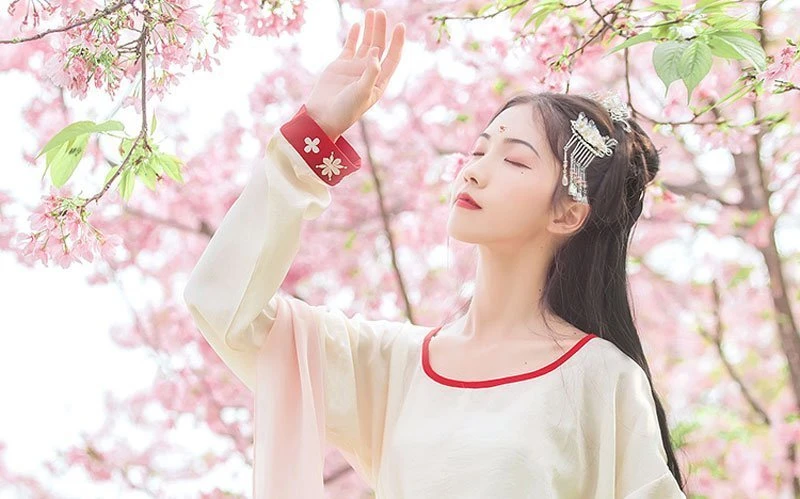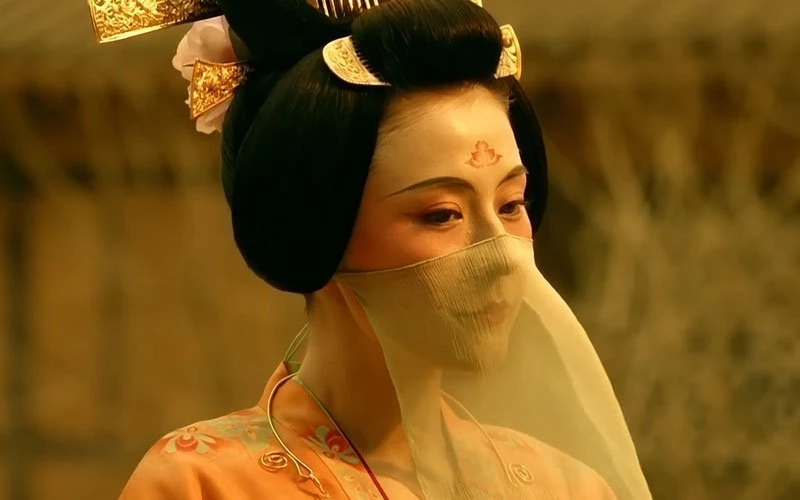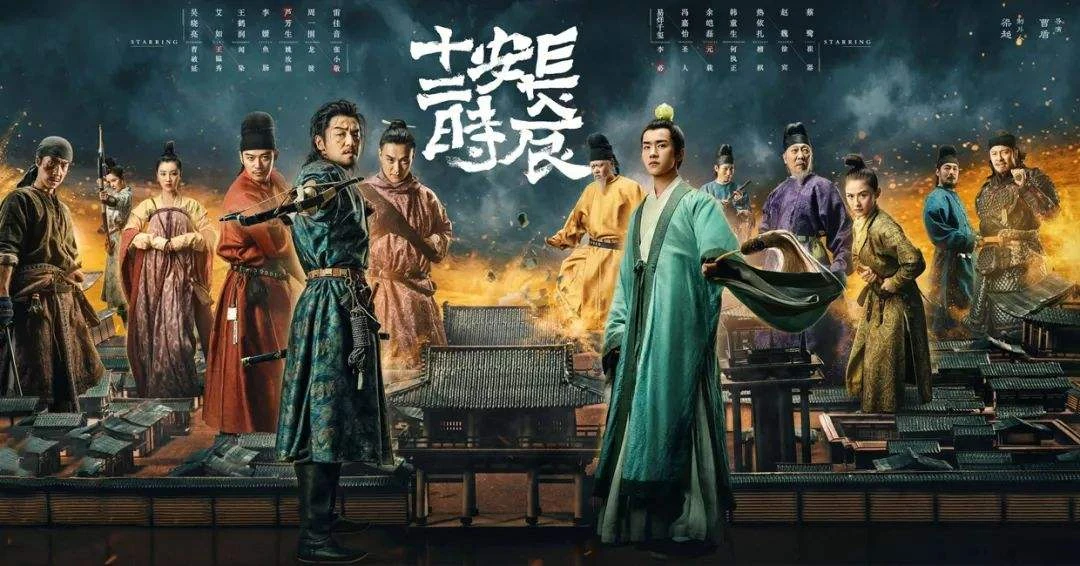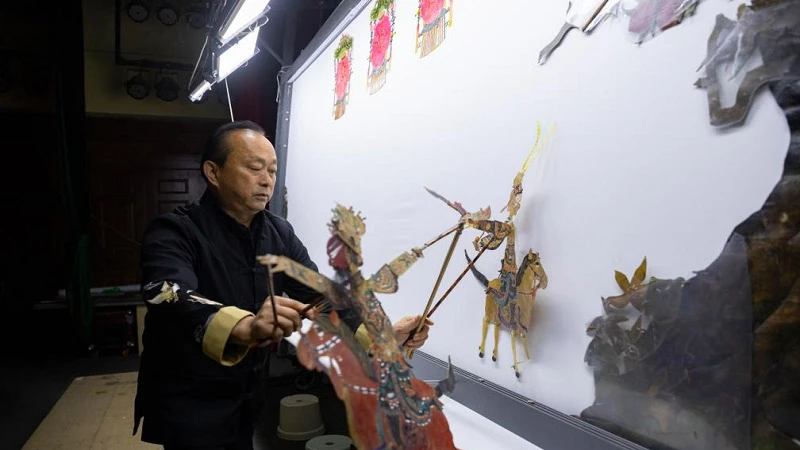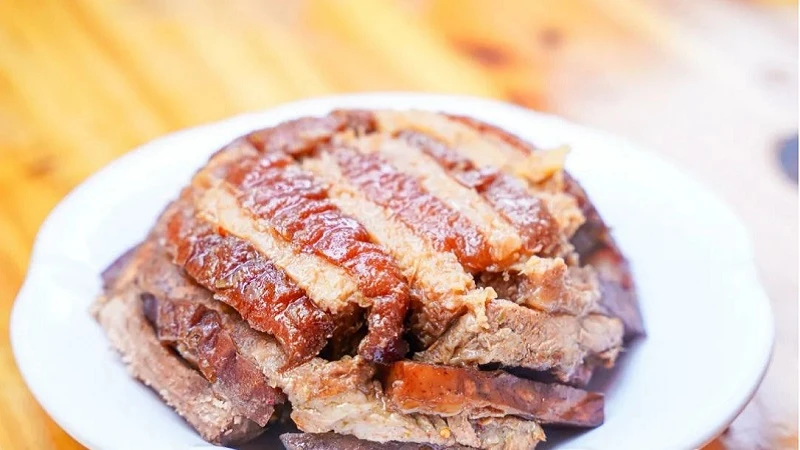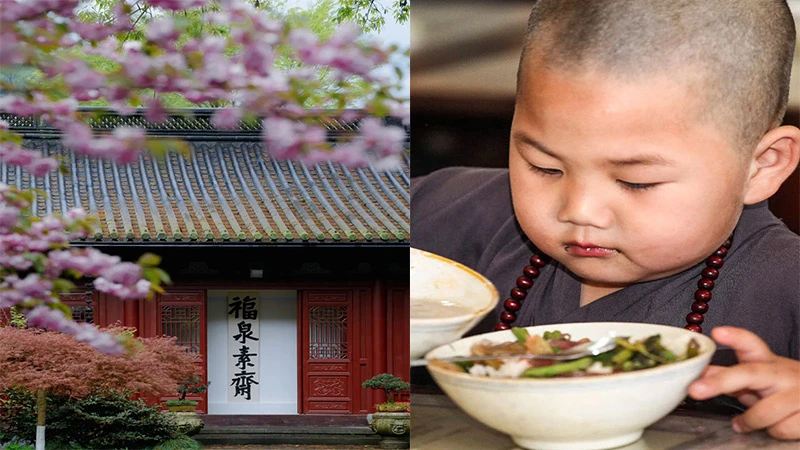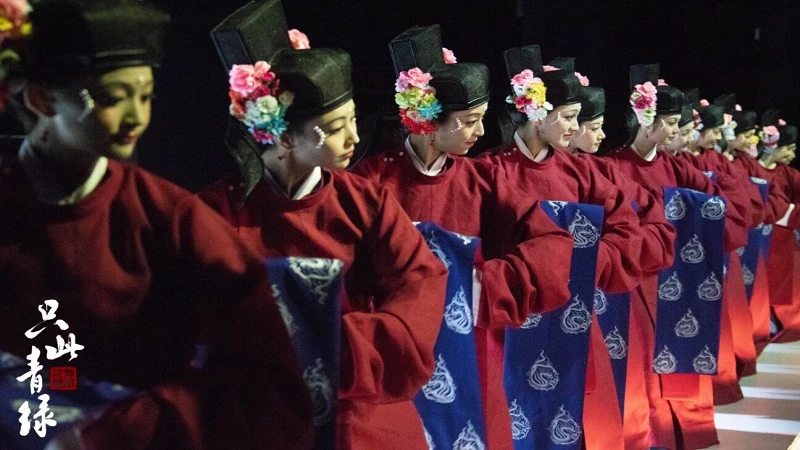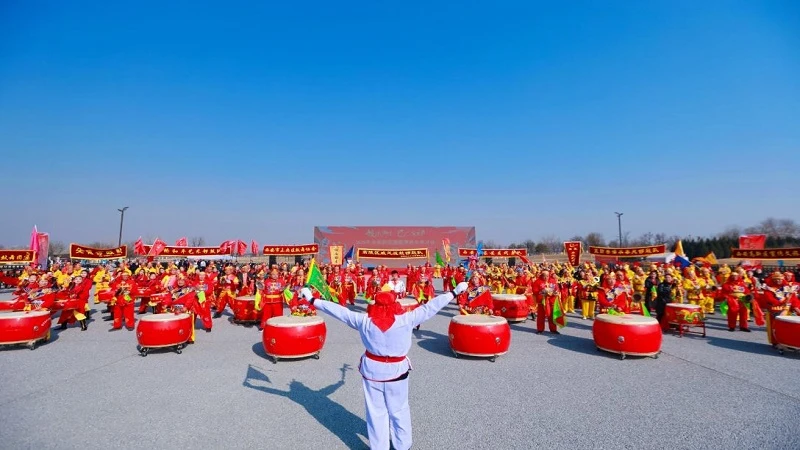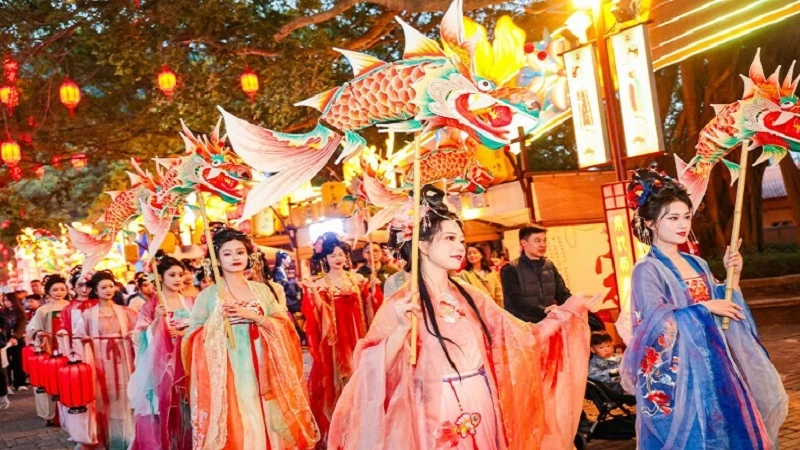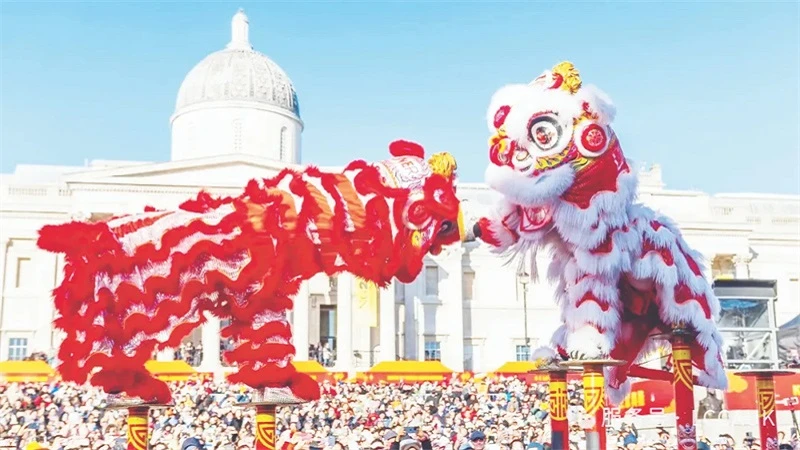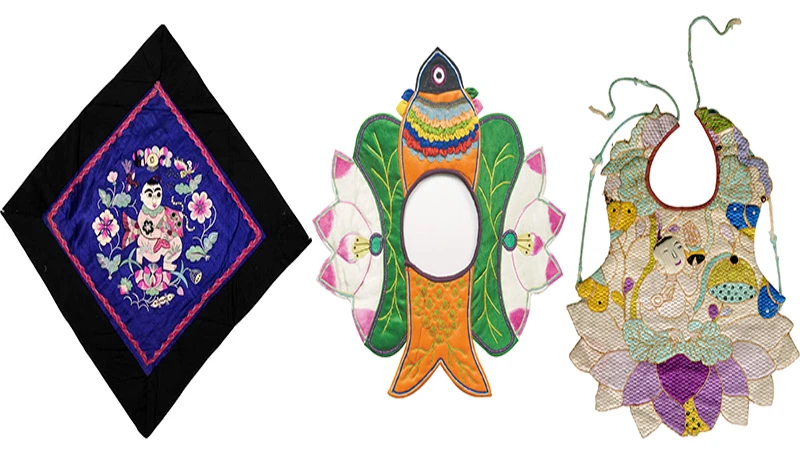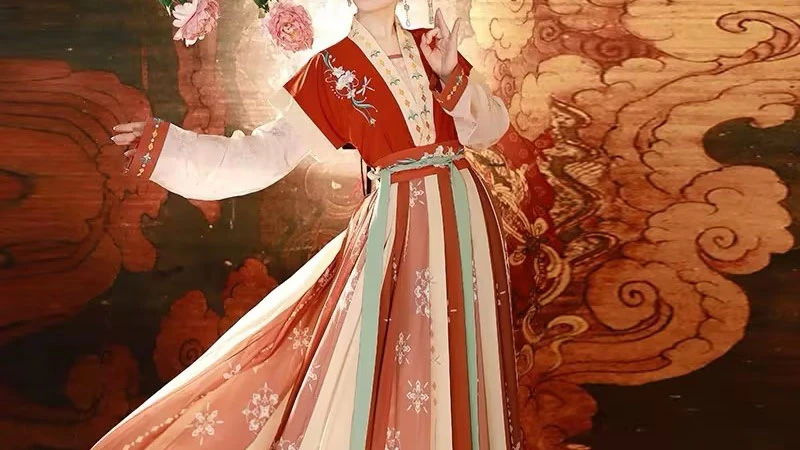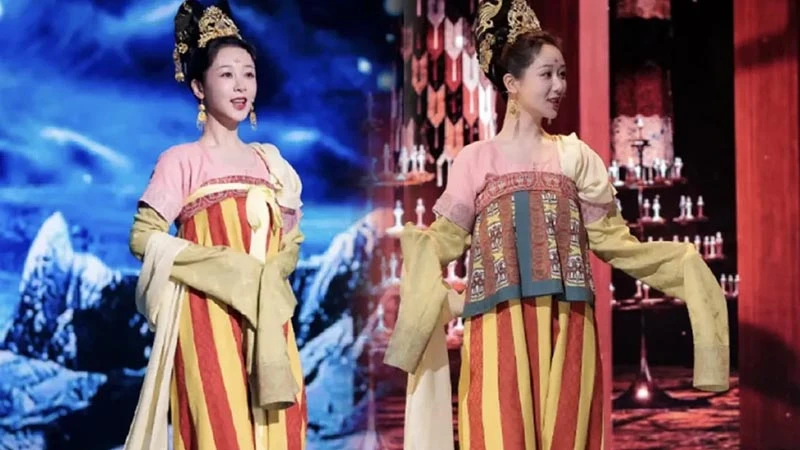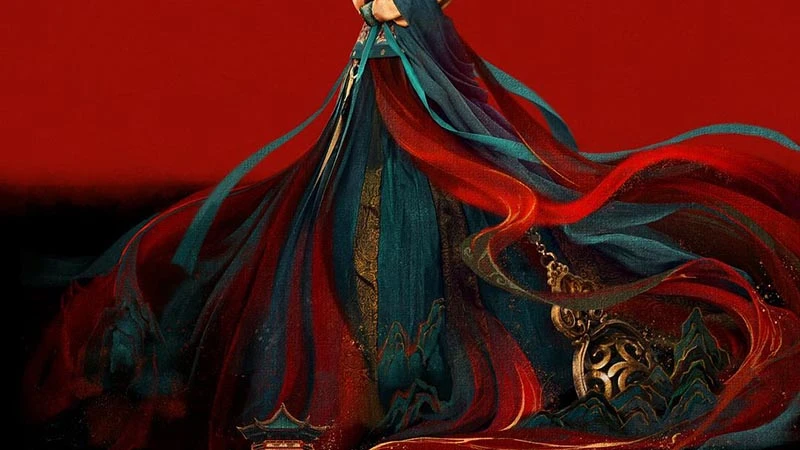Article
搜索结果:
-
Amazed! Hanfu T-shirts were Available in the Tang Dynasty?
We have introduced Banbi (半臂) before, which is a kind of hanfu very suitable for wearing in summer. The tan collar introduced today is a small classification of Banbi. You will find that the shape of the tan collar is very similar to the collar of the T-shirt we usually wear. Tan collar (坦领), also known as U-collar, is a kind of short coat with a wide collar. Some of them cover it outside the skirt, some like today's short windbreaker. The lower body is matched with a long dress, which fully reflects the graceful posture and natural beauty of women in the Tang Dynasty. In the Tang Dynasty, the tan collar was more popular, not only for men and women but also for court uniforms. I spelled out a long picture to introduce it. It's easier to understand: Because of the wide popularity of Hu culture among different classes in the Tang Dynasty, it became a fashion hanfu for women to wear small sleeves in the Tang Dynasty. Popular in the Sui and Tang courts, and later spread to the folk, enduring. There are many conjectures about the origin of the tan collar. One conjecture is that the tan… -
What did the Tang Dynasty wear? | Chang'an Twenty-four Hours
Some time ago, I watched the hot Chinese drama Chang' a Twenty-four Hours (长安十二时辰). I was attracted by the hanfu of the Tang Dynasty in the play. So I did some research on the clothes and fittings of the Tang Dynasty. Let's see who is the most fashionable in Chang'an. Ruqun Talking about the trend of wearing and matching in the Tang Dynasty, it's natural that we can't do without ruqun. Ruqun is one of the most common and distinctive dresses in the Tang Dynasty. The main features of this dress are short clothes on the upper body and long skirts on the lower body. Some of them wear silk shoulders around their arms. Others wear half-arm outside the gown and then wear silk. "Ru (襦)" is for internal wear, sleeve length, upper and lower shorter, just to the waist. Long skirts were the clothes of women in the Tang Dynasty, most of which were made of silk. Skirt waist is high, can hide the chest, outside shoulder put on a yarn shirt, can make upper body skin half-covered, there is a kind of vague aesthetic feeling. Banbi (半臂) is a short-sleeved shirt, sleeve length to the elbow, knotted in… -
The Longest Day in Chang’an: Perfect Reproduction of Tang Dynasty Hanfu
Recently, a TV play, "The Longest Day in Chang'an(长安十二时辰)" is very attractive! It tells the story of the hero defending Chang'an City from the enemy's destruction during the Tang Dynasty. In addition to the glamorous actors, the play also pays tribute to the culture and history of the Tang Dynasty, including traditional costumes, weapons, makeup, architecture and Lantern Festival costumes, which are carefully reproduced on the basis of historical data. Today, let's take a look at the Tang Dynasty hanfu in the TV series. Let's start with the Taoist costumes worn when Jackson Yi appeared. Because of the prevalence of Taoism in the Tang Dynasty, Taoist costumes can be divided into five parts: Tao scarf, Tao crown, Tao gown, shoes and socks, and decoration. Taoist priests have different ranks and wear different clothes. The crane is a commonly used pattern in Taoism, known as "the emergence of immortals into the sky". Men basically wear round collars robe. "Round collar" refers to a collar type that does not wrap around the neck. A button often falls on the right side of the wearer's collar. On informal occasions, the buttons can also be unbuttoned to make the neckline hang down naturally. In… -
Zhejiang's Ancient Wooden Metropolis Reveal Secrets of the Yue Kingdom
In June 2024, a construction site in Shaoxing Binhai New Area accidentally unveiled a 2,500-year-old Yue state metropolis. This waterfront settlement sealed by a marsh not only refreshed the academic community's knowledge of Yue's construction techniques, but also linked the development of the prehistoric wooden civilization in the Yangtze River basin. The construction team initially noticed unusual soil layering - rows of woven reeds interspersed with dark brown silt. Emergency exploration by the Zhejiang Institute of Cultural Relics and Archaeology confirmed that this was a waterfront settlement during the Spring and Autumn and Warring States periods (770-221 BCE). The well-preserved 6th-century BCE wooden pillars unearthed at the site, with standardized mortise and tenon joints visible at their ends, are in the same lineage as the construction techniques of the Tingshan complex, which was discovered in 2020. Archaeologist Xu Tianjin pointed out that this site, together with the core area sites of Tingshan and Nanshantou, constituted the functional area of the capital city of the State of Yue, corroborating the record of "the great city of Shanyin" in the Book of Yuejishu. Architectural Wisdom Beyond the Era The core of the site is a cluster of two dry-structure buildings with a… -
Zhejiang Ancient Roots: 2024's Top 10 Archaeological Discoveries
For a province already celebrated for its UNESCO World Heritage Sites—from West Lake to Liangzhu Ancient City (良渚古城)—Zhejiang continues to rewrite the narrative of China's prehistoric past. The recent announcement of its 2024 Top 10 Archaeological Discoveries offers a thrilling glimpse into civilizations that thrived here up to 10,000 years ago. Among the highlights are the Neolithic Xiatang Village (下汤村), the enigmatic Huangchao Mound (皇朝墩), and two newly unearthed urban relics from Hangzhou. Let's dive into these time capsules reshaping our understanding of East Asia's early societies. Xiatang: A 10,000-Year-Old Time Capsule Nestled in the upper reaches of the Yong'an River Valley, the Xiatang Site (下汤遗址) in Taizhou's Xianju County (台州仙居县) has stunned archaeologists with its near-complete chronicle of Neolithic life. First discovered in 1984, this 30,000-square-meter settlement spans four distinct cultural phases: the Shangshan (10,000–8,500 BCE上山文化), Kuahuqiao (8,000–7,000 BCE跨湖桥文化), Hemudu (7,000–6,000 BCE 河姆渡文化), and Haochuan (4,500–4,000 BCE 好川文化) cultures. "Xiatang is like a fossilized imprint of China's earliest agricultural communities," explains Zhong Zhaobing, lead archaeologist at the site. Recent excavations revealed a sophisticated village layout: defensive trenches, raised earthen platforms, pottery kilns, food-processing areas, and even a ceremonial "plaza" paved with fired clay. Among the 400+ artifacts uncovered—stone tools,… -
When Chinese Dumplings Meet Georgia's Beloved Dumplings
In the rugged landscapes of Georgia, a doughy delicacy bridges continents and centuries. Meet khinkali—Georgia's beloved dumpling, whose pleated folds and savory broth whisper tales of Mongol conquests, Silk Road exchanges, and a culinary resilience that resonates deeply with Chinese sensibilities. At a cooking class in Tbilisi's St. Bunny restaurant, chef Nino Bochorishvili hands me a lump of unleavened dough. As she demonstrates the art of pleating khinkali—pinching 18 spiraled folds to seal spiced meat inside—I'm struck by its uncanny resemblance to Shanghai's xiaolongbao. "Chinese visitors always say this feels familiar," Nino smiles. Yet differences emerge: khinkali is boiled, not steamed, and crowned with a doughy "handle" for easy handling. The eating ritual also sparks cross-cultural déjà vu. Georgians devour khinkali barehanded, slurping the broth first before consuming the rest—a technique mirroring how Shanghainese navigate soup dumplings. "A messy plate means you've mastered it," jokes Guram, our driver, whose father once ate 89 khinkali in one sitting. To a Chinese eater, this evokes the hearty chaos of a Beijing dumpling feast. History Wrapped in Dough The origins of khinkali are as layered as its folds. Chef Tekuna Gachechiladze, a pioneer of modern Georgian cuisine, traces its roots to the 13th-century… -
Bringing Shadows to Life: The Art of Sichuan Shadow Puppetry
A Tradition Carved in Light and Shadow A single sheet of leather, a flickering lantern, and the deft movements of an artisan's hands—these simple elements merge to create a theatrical spectacle that has captivated audiences for centuries. Chinese shadow puppetry, a mesmerizing blend of painting, carving, storytelling, and music, has been recognized by UNESCO as an Intangible Cultural Heritage of Humanity. In the historic city of Langzhong (阆中), Sichuan, the tradition of shadow puppetry has been passed down through generations, evolving while staying true to its roots. The Langzhong style, particularly the famed "Wang Shadow Puppetry," has been performed for over 350 years. Its distinct artistry is inspired by Sichuan opera, featuring intricate designs and vibrant characters cut from cowhide or paper. The narratives often revolve around history, mythology, and folklore, bringing to life stories that transcend time. A Master's Journey One of the most dedicated guardians of this tradition is Wang Biao, a seventh-generation heir of the Wang Shadow Puppetry lineage and a national-level inheritor of Sichuan shadow puppetry. Born in 1965, Wang Biao was immersed in the craft from an early age, learning both performance techniques and the delicate art of puppet carving from his grandfather, Wang Wenkun.… -
Lipu Taro Braised Pork: The Star of Guangxi Banquets
In Guangxi, no banquet is complete without a steaming plate of Lipu Taro (荔浦芋头) Braised Pork. This beloved dish holds a special place in local culinary traditions, earning its reputation as the undisputed centerpiece of celebratory feasts. From family gatherings to grand wedding banquets, it consistently takes the spotlight, delighting diners with its rich aroma and melt-in-your-mouth texture. Everyday Favorite Lipu taro is the key ingredient that sets this dish apart. Known as the "King of Taro," Lipu taro boasts a high starch content, giving it a soft, creamy texture with a hint of sweetness. The region has cultivated this prized crop for over a thousand years. Historical records indicate that as early as the Qing Dynasty, Lipu taro was selected as an imperial tribute, enjoyed by royalty for its superior quality. Lipu Taro Braised Pork dates back to the Ming Dynasty. Legend has it that devout worshippers once offered pork and taro as temple sacrifices. After the ceremony, they combined the ingredients, steamed them with seasonings, and unknowingly created what would become one of Guangxi's most iconic dishes. Over time, what was once a delicacy reserved for special occasions has become a household staple, enjoyed by families across China… -
A Flavorful Tradition: Vegetarian Cuisine in Chinese Temples
In China, temples are often seen as places of worship, offering a peaceful escape from the hustle of everyday life. However, a lesser-known but equally delightful aspect of temple life is the cuisine—especially the humble yet hearty vegetarian dishes served within their ancient walls. Far from the notion that vegetarian food lacks flavor or excitement, these temple-based dishes prove otherwise. From noodles to savory snacks, the temples of China serve some of the most delightful meals, blending spiritual tradition with culinary craftsmanship. Though temple food is strictly vegetarian, the variety and depth of flavors can be surprising. Consider the staple dish in many temples: vegetarian noodles. These aren't just any noodles, but dishes steeped in rich, aromatic broths that are painstakingly crafted with an assortment of vegetables, mushrooms, and tofu, designed to nourish both the body and spirit. Let's take a look at some of the best temples to visit if you're looking for not just peace but a truly delicious vegetarian experience. Temple Noodles In Suzhou, a city famed for its sophisticated culinary traditions, even the temple noodles stand out. At Lingyan Mountain Temple and Xiyuan Temple, locals and tourists alike gather early in the morning to enjoy a… -
How Does Mapo Tofu Transcends Borders
No Chinese dish has achieved global recognition quite like Mapo Tofu. What began as a humble street food in 19th-century Chengdu has evolved into a culinary symbol bridging cultures, inspiring chefs, and sparking debates across continents. Its journey—woven with history, creativity, and a dash of misunderstanding—reveals how a single dish can transcend borders. In 1994, two seemingly unrelated events set the stage for Mapo Tofu's global breakthrough. Fuchsia Dunlop, a British scholar, arrived in Sichuan to study Chinese minorities but soon found herself enrolled at the Sichuan Culinary Institute. There, she mastered the art of Mapo Tofu, later introducing it to Western audiences through her books and documentaries. Meanwhile, in Japan, manga artist Etsushi Ogawa debuted Cooking Master Boy (中华一番), a culinary adventure series where the protagonist's triumph hinges on a mythical "Magical Mapo Tofu." These two narratives—one rooted in scholarship, the other in pop culture—propelled the dish into international consciousness. Dunlop became a tireless advocate for Sichuan cuisine, demystifying its history and honoring Chen Mapo, the 19th-century matriarch credited with creating the dish. Ogawa's manga, meanwhile, spawned anime adaptations and a cult following, transforming Mapo Tofu into a symbol of culinary heroism. The Name The dish's global journey wasn't… -
The Eternal Verdant Approaches 700th Performance
Beneath the vaulted ceilings of Guangzhou Opera House, silk cascades like ink dispersing in water, unveiling the 700th iteration of a modern cultural marvel. Since its 2021 premiere, The Eternal Verdant: The Journey of a Legendary Landscape Painting (只此青绿)—a dance poetry drama inspired by the 12th-century masterpiece A Thousand Li of Rivers and Mountains—has transcended theatrical boundaries, becoming a living bridge between Song Dynasty artistry and contemporary sensibilities. Co-created by the Palace Museum and China Oriental Performing Arts Group, this production has magnetized over 1.2 million viewers across 70 cities, from Istanbul's ancient theaters to Broadway's neon glare, collecting accolades like the Wen Hua Award while redefining China's cultural narrative. The genius of The Eternal Verdant lies in its alchemical fusion of disciplines. Dancers don't merely perform; they become brushstrokes incarnate. Limbs curve like mountain ridges traced by Wang Ximeng, the teenage prodigy behind the original painting, their movements oscillating between the tensile grace of calligraphic flourishes and the raw energy of mineral pigment grinding. Silk costumes, dyed using reconstructed Song-era malachite formulas, ripple to reveal hidden cartographies of the landscape. Audiences find themselves not just spectators but time travelers, drawn into a dual narrative where a modern museum researcher's… -
Spring Festival in Shaanxi: The Unique Ancient Drums
Xi'an's ancient city walls trembled not from winter winds, but from the thunderous artistry of 500 drummers. At the Han Dynasty Heritage Park, the air buzzed with anticipation as teams from Chang'an District, Zhouzhi County, and Yanliang District prepared for the "Drum Symphony of Prosperity" competition. Among them, the Chang'an troupe's "The Emperor's Review" (秦王点兵) stood out—a six-movement epic that reimagined Qin dynasty military drills through percussive storytelling. Fourteen-year-old Liang, his drumsticks wrapped in crimson silk, leaned toward his teammate. "The third movement mimics cavalry hooves," he whispered, as holographic warriors materialized above their drums. Nearby, the Lantian County troupe rehearsed "West River Folk Pageant" (西川社火), their cymbals spinning like golden harvest moons. "Each clash echoes our ancestors' celebrations after defeating floods," explained veteran performer Grandma Liu, her wrists flicking with the precision of a calligrapher's brush. The climax came when Zhouzhi County's drummers unleashed their "digital dragon"—a 50-meter LED projection that snaked through the air, its scales rippling to the rhythm of a 13th-century battle hymn. Tech-artist Mei, whose VR headset transformed drum scores into 3D calligraphy. Our ancestors carved prayers into oracle bones; we code them into light. Soil-Stained Hands, Skyward Rhythms In Fuping's frozen fields before dawn,… -
Cyber Park Lantern Festival in Vibrant Bay Area
On the evening of January 22, 2025, the Guangdong-Hong Kong-Macao Greater Bay Area Lantern Festival (1.22-3.30) kicked off with a dazzling display of lights. The first visitors to the park witnessed the spectacular moment as thousands of lanterns illuminated the night sky, offering a mesmerizing view of a world lit up by modern technology and traditional art. "3, 2, 1, Light Up!" With a countdown in the air, lanterns from three major parks—Nansha Puzhou Garden, Nansha Tianhou Temple, and Nansha Seaside Park—simultaneously lit up the night sky. This moment marked the beginning of a breathtaking visual journey, with thousands of lights forming intricate designs that captivated the eyes of onlookers. The first evening drew crowds of visitors eager to witness the magic. One of the standout features of this year's display is the lantern "The Flower Goddess (簪花女神)," which was set against a serene water-side backdrop. The graceful figure of the flower goddess, depicted in intricate detail, transported visitors to a tranquil water town, offering a beautiful juxtaposition between nature and craftsmanship. Another popular installation, "The Monkey King," reimagined the famous character of Sun Wukong from Chinese mythology. The lantern's unique dark fantasy style transformed the beloved hero into a mysterious, almost mythical figure,… -
Nanjing Blooms: A Spring Awakening and Cherry Blossoms
From January 1 to March 31, 2025, travelers arriving via China Eastern Airlines or rail services to Nanjing can unlock exclusive discounts at 23 iconic attractions—from the mist-shrouded Qixia Mountain to the lively Hongshan Forest Zoo. Simply present your boarding pass or train ticket within 10 days of arrival to enjoy up to 40% off tickets and experiences. But here's the real showstopper: March marks the awakening of Jiming Temple's (鸡鸣寺) legendary cherry blossoms. While Tokyo's sakura often steal the spotlight, Nanjing's 400-meter "Pink Corridor" offers an ethereal alternative. Picture delicate petals swirling around ancient temple eaves, accompanied by the soft chime of Buddhist bells—a scene so poetic it could make Kyoto blush. Nanjing offers an antidote to overcrowded Japanese hanami spots. As one guest remarked: "It's like stepping into a scroll painting—one where you can sip cappuccino amid cherry blossoms." Back at the legendary Jiming Temple Road, anticipation builds around the "Messenger Tree"—a lone Chunhan Cherry (春寒樱花) that traditionally heralds the main bloom. Though still cloaked in tight buds, early risers might spot a dozen pioneering flowers defying the chill. "This variety accounts for 80% of our cherry canopy," says local arborist Wang. "Once temperatures stabilize above 12°C, the entire 2km… -
Dragon Dances Meet Digital Skies in Spring Festival
Kuala Lumpur's night sky ignited as 1,200 drones wove luminescent dragons above the Petronas Towers, officially launching the 2025 "Happy Spring Festival" global tour. In Bangkok's Yaowarat district, the scent of tom yum soup mingled with sizzling Chaozhou dumplings as over 100,000 locals and overseas Chinese flooded the neon-lit streets. "Sharing this festival has become our bridge," remarked Thailand's Tourism Minister Sudawan Wangsuphanakul, gesturing to crowds where Thai silk sarongs brushed against Hanfu sleeves. The UNESCO-listed festival's first year as intangible heritage saw unprecedented fusion. Brussels' Royal Museums of Fine Arts hosted children stamping Suzhou's peach-blossom woodblock prints onto Flemish-style canvases, while Greek Parthenon steps echoed with Kunqu opera arias. "It's like watching a Renaissance muse awaken to a Chinese melody," marveled Belgian curator Antoine Delvaux. Southeast Asia's celebrations shimmered with layered identities. Singapore's Clarke Quay transformed into a living Analects: youths in Peranakan-embellished Hanfu practiced archery beside QR-coded lantern riddles. "The ‘Six Arts' aren't relics—they're life hacks for modern minds," laughed Malaysian student Mei Ling, her calligraphy brush tracing Confucian maxims onto augmented-reality scrolls. Jakarta's National Monument witnessed a culinary diplomacy coup—Shenyang chefs reimagined nian gao rice cakes with durian fillings, served alongside VR tours of China's ice festivals.… -
Ne Zha in Guangzhou Museums
As one of Chinese mythology's most iconic figures, Ne Zha—the fearless boy deity wielding a Fire-tipped Spear and Cosmic Ring—has transcended centuries through folklore, literature, and modern media. Beyond today's cinematic adaptations, Guangzhou's museums safeguard a treasure trove of artifacts that reveal how this cultural icon captivated imaginations long before the age of blockbusters. From ancient porcelain to architectural masterpieces, Ne Zha's legacy intertwines with Guangzhou's history as a hub of art, trade, and storytelling. Let's explore his enduring presence across the city's collections. Ne Zha Sails Overseas During the 18th and 19th centuries, Guangzhou's bustling port fueled a golden age of ceramic exports. Among these treasures, a Qing Dynasty Fencai (粉彩) "Investiture of the Gods" (封神演义) vase at the Guangzhou Museum stands out. Painted with vivid scenes from the Ming-era epic, the vase immortalizes Ne Zha's battle against the Dragon King—a tale later popularized by modern films. This artifact underscores how Guangzhou's artisans transformed literary classics into globally traded art. Export porcelain of this era often featured narratives from Romance of the Three Kingdoms or Journey to the West, but Ne Zha's inclusion highlights his timeless resonance. Centuries before animation studios reimagined him, his legend traveled to Europe and… -
8 Perfect Gift Choices for Chinese Culture Lovers
Do you have Chinese friends or friends who like traditional Chinese culture? When they need gifts for birthdays or special holidays, do you worry about what gifts to give to make them considerate? As we all know, traditional Chinese culture is extensive and profound. The influence of Chinese culture is also deepening around the world. Various traditional skills deeply attract everyone's attention. You don't have to work hard to find his preferences, these gift options are very suitable for her/him! Gifts for clothing matching 1. Hanfu or cheongsam: For friends who take a great interest in ancient Chinese clothes, choosing an exquisite Hanfu or cheongsam is not only a unique gift but also access to understanding Chinese culture. And the clothing of different dynasties is even more dazzling and unique whether it’s in the Tang Dynasty or Song Dynasty. 2. Custom Patches: Custom patches with ancient elements are also a wonderful choice. For friends or fans who love Chinese culture deeply, choosing exquisite embroidered patches as gifts can not only be a special gift for most festivals but also a good way for Chinese culture lovers to decorate beautiful clothes. Customized embroidered patches are of various styles and types, suitable… -
The Evolution of the Wei Shang in Chinese Fashion
In the recently aired historical drama Flourished Peony (国色芳华), eagle-eyed viewers noticed something peculiar about Dong Jie’s (董洁) character, Feng Xiaoyi (冯小姨): she wore a curious piece of fabric draped across her chest, resembling what modern audiences might jokingly call a “butt curtain.” This accessory, however, is far from a mere costume quirk—it’s a revival of the Wei Shang (围裳), a centuries-old fashion staple from the Tang Dynasty (618–907 CE). What Is a Wei Shang? The Wei Shang, often referred to as a “waist skirt” or yao qun (腰裙), is a versatile garment that wraps around the waist or hips. Historically, it served both decorative and functional purposes. According to The Dictionary of Ancient Chinese Clothing, the Wei Shang was a short skirt worn around the waist, while scholars like Ruan Li (阮立) from Shanghai University describe it as a wide band tied at the hips, often secured with decorative knots or beads. In simpler terms, the Wei Shang is a layered piece of fabric that adds depth and structure to an outfit. Its design can range from a single piece of cloth to multiple panels stitched together, often pleated or embroidered for added flair. From Waist to Chest: A… -
The Multifaceted Role of Round Fans in Chinese History
When we think of round fans, or tuanshan (团扇), images of graceful women in flowing robes often come to mind. Yet, the origins of this iconic accessory tell a different story—one where men, not women, were the primary users. From its inception as a tool of etiquette to its evolution into a symbol of feminine beauty, the round fan’s journey through Chinese history is as rich and layered as the silk it was often made from. A Man’s World: The Early Days of Round Fans Contrary to popular belief, round fans were not always associated with women. During the Han Dynasty (206 BCE–220 CE), these fans emerged as a practical accessory for men, particularly among scholars and aristocrats. Known as gongshan (宫扇) or “palace fans,” they were initially used to shield one’s face—a gesture of modesty or social avoidance. Historical records, such as the Book of Han (《汉书》), describe how officials used fans to avoid awkward encounters, a practice humorously akin to modern-day “social distancing.” By the Tang Dynasty (618–907 CE), round fans had become a staple of courtly life. Their designs evolved from simple bamboo frames to intricate works of art, often adorned with calligraphy, paintings, or delicate embroidery.… -
The 1500-Year-Old Striped Skirts That Rival Modern Fashion
In the bustling streets of modern cities, striped skirts have become a staple of contemporary wardrobes. But what if we told you this trend was mastered—and arguably perfected—over 1,500 years ago in China? Recent archaeological discoveries and historical dramas like Kill My Sins (掌心) have reignited fascination with ancient Chinese striped skirts, revealing a sophisticated fashion legacy that continues to inspire today. The Striped Skirt Revolution: A 7th-Century Innovation Contrary to popular belief, striped skirts were not born on Parisian runways or New York streets. The earliest examples emerged during China’s Han Dynasty (206 BCE–220 CE) and evolved into a cultural phenomenon by the Tang Dynasty (618–907 CE). These were no ordinary garments: Engineering Elegance: Unlike modern printed fabrics, Tang-era striped skirts (poqun, 破裙) were painstakingly assembled from narrow, hand-dyed fabric strips—sometimes as many as 90 panels stitched together. Optical Illusions: Ancient tailors strategically used vertical stripes and color contrasts (like black-white or red-blue) to create slimming silhouettes, predating modern "bodycon" aesthetics by over a millennium. Functional Fashion: Excavated artifacts from tombs like Bi Jiatan Huahai (毕家滩花海墓) reveal skirts with pleats and adjustable waistbands, blending artistry with practicality. How Tang Women Wore Stripes The Tang Dynasty’s striped skirt craze reached…
